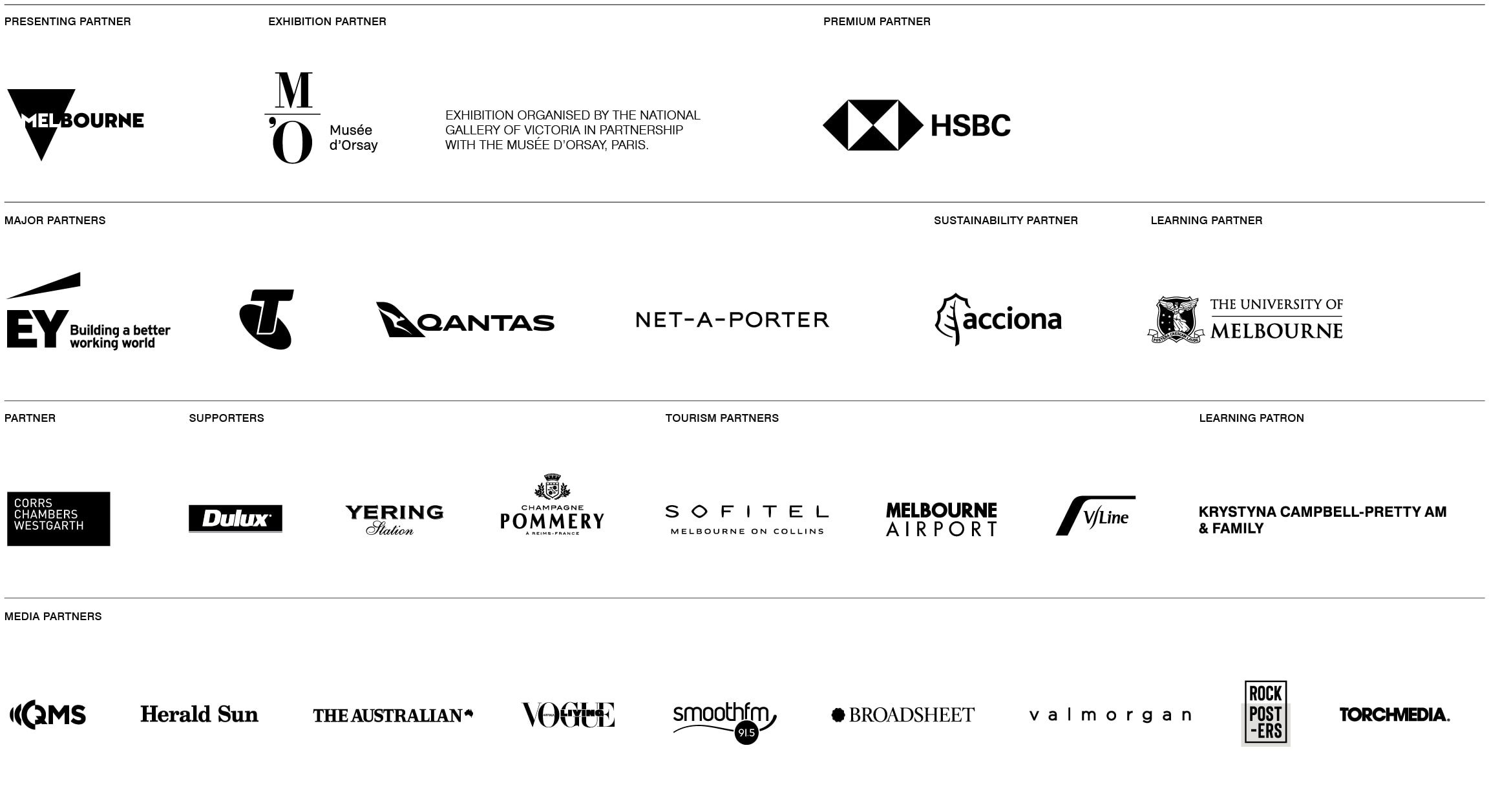A kaleidoscopic exhibition,
Pierre Bonnard features more than 100 works by the celebrated French artist, spanning the late nineteenth century and the first half of the twentieth century. Paintings, drawings, photographs, folding screens and early cinema will bring modern France to life with startling beauty and vivid colour. Developed in partnership with Musée d’Orsay, Paris, the exhibition is largely drawn from the museum’s impressive holdings of works by Bonnard alongside significant loans from other collections in France and beyond.
The first sections of the exhibition explore Bonnard’s central role within the Nabi circle of artists, as well as his interaction with the contemporary worlds of music and theatre. Calling themselves the Nabis, the young artists Pierre Bonnard, Maurice Denis, Édouard Vuillard, Paul Ranson, Paul Sérusier and Félix Vallotton banded together in the early 1890s, and saw themselves as the Prophets of a new art that they envisaged encompassing every sphere of modern life – interior design, furniture, fans and textiles, stained glass, and commercial illustration and advertising. Paintings by Vuillard and Vallotton will be shown alongside prints by Denis.
During this period, Bonnard recorded daily life in the streets of Paris in an immediate and startlingly close manner, observing what he called the ‘theatre of the everyday’. Influenced by his friendship with the pioneering filmmakers, Auguste and Louis Lumière, he became one of the first artists to draw inspiration from the new medium of cinema in his art. He also embraced photography and cast his artist’s eye over his family circle to capture moments of unexpected movement and impromptu composition. Films by the Lumière Brothers are screened alongside dynamic urban scenes Bonnard produced during this period.
Bonnard’s meeting with Maria Boursin (who chose to be called Marthe de Méligny) in 1893 led to his own domestic intimacy, culminating in a remarkable series of nude studies, both lithographs and paintings. As Bonnard and de Méligny shared their life together, this led to longer periods spent in the countryside for the latter’s health. Alongside his intimate studies of their domestic life, Bonnard undertook campaigns of landscape painting, engaging with the legacy of French Impressionism. Visits to the south of France from 1909 onwards brought a new intensity of colour to Bonnard’s art, ‘this colour that drives one wild’ as he put it. A rich selection of the warm and vibrant interior scenes and still lifes recorded by Bonnard following his move to the south of France form an important part of the exhibition. In the last decades of his working life, Bonnard created works of poignant introspection – self portraits and scenes of his daily life – and others of majestic scale and joyous colour, celebrating the luminous landscapes around Le Cannet, the town near Cannes on the French Riviera where he and de Méligny lived.
For Pierre Bonnard, the NGV has commissioned celebrated architect and designer India Mahdavi to design the exhibition’s scenography. Described by The New Yorker as a ‘virtuoso of colour’ and ‘possessor of perfect chromatic pitch’, Mahdavi envelops Pierre Bonnard’s works in an environment that complements the artist’s distinct use of colour and texture, and the domestic intimacy for which his paintings are so renowned.
A design icon, Mahdavi has appeared multiple times on Architectural Digest’s list of the world’s 100 most influential architects and designers. Her singular approach to colour, structure and texture has resulted in numerous acclaimed projects, including commissions for hotels, restaurants and retail as well as scenography for exhibitions and fairs, including for Design Parade Toulon and Homo Faber, Venice. Mahdavi engages with both art history and contemporary culture to create a unique exhibition experience with Bonnard’s works. Wall and floor applications, as well as furniture, add a three-dimensional experience to the sumptuous, domestic interior worlds synonymous with Bonnard’s paintings.
Exhibition organised by The National Gallery of Victoria, Melbourne in partnership with the Musée d’Orsay, Paris.
皮埃尔·博纳尔展览缤纷绚丽,将呈现这位著名的法国艺术家从19世纪末到20世纪上半叶创作的100多件作品。油画、素描、摄影、折叠屏风和早期电影将以绝伦美景和鲜艳色彩勾勒出现代法国的生动画面。这次展览是与巴黎的奥赛博物馆(Musée d’Orsay)合作举办的,展品主要来自奥塞博物馆出色的博纳尔藏品,以及从法国和其他国家的馆藏租借的重要作品。
展览的前几部分探讨了博纳尔在纳比派艺术家圈子中的核心角色,以及他与当代音乐和戏剧界的互动。皮埃尔·博纳尔、莫里斯·丹尼(Maurice Denis)、爱德华·维亚尔(Édouard Vuillard)、保罗·兰森(Paul Ranson)、保罗·塞鲁西埃(Paul Sérusier)和费利克斯·瓦洛顿(Félix Vallotton)等年轻艺术家在19世纪90年代早期组成纳比派,他们认为自己是一种新的艺术形式的先知,并且设想这种艺术形式将涵盖现代生活的各个领域,如室内设计、家具、扇子和纺织品、彩色玻璃、商业插图和广告。展览将展出维 亚尔和瓦洛顿的画作以及丹尼的版画。
在这一时期,博纳尔以一种即时而惊人的近距离方式记录了巴黎街头的日常生活,观察他所说的“日常生活的剧院”。受他与先驱电影人奥古斯特和路易斯·卢米埃兄弟(Auguste and Louis Lumière)的友谊的影响,博纳尔成为第一批从新兴的电影媒介中汲取灵感的艺术家之一。他还热爱摄影,并用艺术家的眼光审视自己的家庭成员,捕捉意想不到的运动和即兴构图的瞬间。卢米埃兄弟的影片与博纳尔在这一时期创作的充满活力的城市场景比邻放映。
博纳尔在1893年与玛丽亚·波辛(Maria Boursin,玛丽亚自称为玛尔特·德·梅利尼)相遇,这也给博纳尔本人带来了家庭亲密关系,这一亲密关系在一系列引人注目的裸体习作中达到高潮,作品包括石版画和油画。博纳尔和德·梅利尼共同生活,为了后者的健康,他们更多地在乡村度日。除了描绘自家生活的亲密习作外,博纳尔还投身于风景画运动,与法国印象派的传统互动。从1909年开始,博纳尔频频前往法国南部,这为他的艺术带来了新的色彩强度,正如他所说,“这种颜色让人发狂”。博纳尔搬到法国南部后,创作了大量温暖而充满活力的室内场景和静物作品,这些作品构成了展览的重要组成部分。在职业生涯的最后几十年里,博纳尔创作了一些痛苦的自省作品(如自画像和日常生活的场景)以及其他规模宏大、色彩欢快的作品,赞美了博纳尔和德·梅利尼居住的法国里维埃拉(Riviera)地区戛纳附近的小镇勒坎内(Le Cannet)周围明亮的风景。
为筹备皮埃尔·博纳尔展览,维州国立美术馆委托著名建筑师和设计师英迪娅·马赫达维设计展览的布景。《纽约客》杂志把马赫达维称为“色彩大师”和“拥有完美色彩感的人”。她为皮埃尔·博纳尔的作品打造出的环境,与博纳尔对色彩和质地的独特使用以及他画作中著名的家庭亲密感相辅相成。
作为设计名家,马赫达维多次出现在《建筑文摘》评选的全球100位最具影响力的建筑师和设计师名单上。她对色彩、结构和质地的独特处理方式令她接手的众多项目备受赞誉,包括她被委任设计的酒店、餐厅和零售店,以及展览和博览会的布展,包括土伦设计节(Design Parade Toulon)和威尼斯的创意展览(Homo Faber)。马赫达维结合艺术史和当代文化,为博纳尔的作品打造了独特的观展体验。墙面和地面装饰以及家具的应用,为博纳尔画作中展现的华丽的家庭内部世界增添了立体的体验。
展览由墨尔本维多利亚州国立美术馆与巴黎奥赛美术馆合作举办。




